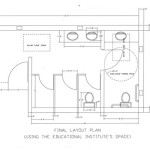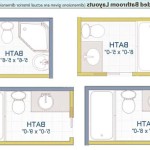Are Bathroom Fans Standard Size? A Comprehensive Guide
The question of whether bathroom fans are a standard size is a common one for homeowners undertaking renovations, replacements, or new construction. The answer, like many things in the construction and home improvement realm, isn't a simple yes or no. While there are common dimensions and specifications, a true "standard size" doesn't universally exist in the way one might expect for, say, a universally sized light bulb. The factors impacting the size and selection of a bathroom fan are complex, influenced by the bathroom's size, ventilation needs, and pre-existing infrastructure.
Often, when people consider "standard size," they may be thinking about the dimensions of the fan housing itself, the duct size, or the airflow capacity (measured in cubic feet per minute, or CFM). Each of these aspects has typical ranges, but these ranges are dictated by the specific requirements of the bathroom rather than a rigid, industry-wide standard.
This article will delve into the nuances of bathroom fan sizing, exploring the dimensions, airflow considerations, installation complexities, and factors that influence the optimal choice for a given bathroom. By understanding these elements, homeowners and contractors can make informed decisions regarding bathroom ventilation and ensure a safe, comfortable, and moisture-free environment.
Understanding Airflow Capacity (CFM) and Bathroom Size
The most crucial element in selecting a bathroom fan is its airflow capacity, measured in CFM. The CFM rating indicates the volume of air the fan can exhaust per minute. A fan with an insufficient CFM rating will not effectively remove moisture and odors, potentially leading to mold growth, paint peeling, and structural damage. Conversely, a fan with an excessively high CFM rating can lead to energy waste and an uncomfortable draft.
A common rule of thumb for determining the appropriate CFM is to use the square footage of the bathroom. A general guideline recommends one CFM per square foot of bathroom space. For example, a 50-square-foot bathroom would ideally require a 50 CFM fan. This is a simplifying approach but serves as a useful starting point.
However, this square footage rule is not a universally applicable solution. Bathrooms with high ceilings, unusual layouts, or specific moisture-generating features like steam showers or whirlpool tubs necessitate a more nuanced calculation. For high ceilings (over 8 feet), an adjustment factor is required. The volume of the room (length x width x height) should be calculated, and the CFM rating should be sufficient to exchange the air at least eight times per hour. This translates to requiring a CFM rating equal to the room's volume divided by 7.5 (60 minutes/hour divided by 8 air changes/hour).
For bathrooms with steam showers or whirlpool tubs, the Home Ventilating Institute (HVI) recommends a higher CFM rating. Steam showers, in particular, generate significant moisture, and a fan rated for at least one CFM per square foot of shower enclosure surface area is advisable. Similarly, bathrooms with whirlpool tubs benefit from higher CFM fans to effectively remove the increased humidity.
It's also crucial to consider the length of the duct run when selecting a fan. Longer duct runs, especially those with bends or elbows, reduce the fan's effective CFM. The longer the duct run, the higher the initial CFM rating the fan needs to compensate for the friction and resistance within the ductwork. Consulting the fan manufacturer's specifications will provide guidance on CFM reduction per foot of duct run and per elbow used.
In summary, while there isn't a standard CFM rating, bathrooms generally require airflow capacities ranging from 50 CFM for small bathrooms to 110 CFM or higher for larger bathrooms or those with specific moisture-generating features. Accurate CFM calculation is paramount for effective bathroom ventilation.
Bathroom Fan Housing Dimensions and Installation Considerations
The physical dimensions of the bathroom fan housing are another factor to consider. These dimensions are influenced by the fan's CFM rating, the type of fan (e.g., ceiling-mounted, wall-mounted, inline), and the features included (e.g., light, heater, humidity sensor). While there isn't a "standard size," there are common ranges and considerations for typical installations.
Ceiling-mounted bathroom fans, the most common type, are typically designed to fit between standard ceiling joists. Common joist spacing is 16 inches on center (OC), which means the space between the joists is roughly 14.5 inches. Fan housings are therefore often designed to be smaller than this width, allowing for relatively easy installation between the joists. Common housing dimensions for ceiling-mounted fans range from 8 inches to 12 inches in width and length, with a depth of 6 inches to 8 inches. Larger and higher CFM fans may have larger housings.
When replacing an existing fan, it's generally easier to choose a new fan with similar housing dimensions. This minimizes the need for structural modifications to the ceiling. However, if the existing fan is undersized or outdated, upgrading to a larger fan may be necessary, which might require cutting the ceiling joists or installing additional support framing. Cutting ceiling joists should only be done by a qualified professional, as it can compromise the structural integrity of the ceiling.
Wall-mounted bathroom fans are less common but can be a viable option when ceiling access is limited. These fans are typically smaller and have lower CFM ratings than ceiling-mounted fans. Their dimensions vary depending on the design, but they are generally more compact to fit within a wall cavity. Wall-mounted fans often require access to an exterior wall for venting.
Inline bathroom fans, also known as remote-mounted fans, offer a flexible solution for bathrooms with complex ductwork or multiple ventilation needs. These fans are installed within the ductwork, typically in the attic or another remote location, rather than directly in the bathroom. Inline fans can handle higher CFM ratings and can be used to ventilate multiple bathrooms or fixtures. The size of the inline fan housing depends on the CFM rating and the duct size, but they are generally larger than ceiling-mounted fans.
Installation also involves considering the duct size. Most bathroom fans use either 4-inch or 6-inch diameter ducts. The appropriate duct size depends on the fan's CFM rating and the length of the duct run. Using a duct that is too small can restrict airflow and reduce the fan's effectiveness. The manufacturer's specifications will indicate the recommended duct size for optimal performance. In some cases, transitioning to a larger duct size may be necessary to improve airflow, especially for longer duct runs.
In conclusion, while specific “standard” housing dimensions are elusive, ceiling-mounted fans typically fall within an 8-inch to 12-inch range in width and length, designed to fit between standard ceiling joists. Careful consideration of existing infrastructure and ductwork, as well as the fan's CFM rating, is crucial for successful installation.
Features and Factors Beyond Size
Beyond the physical size and CFM rating, several other features and factors influence the selection and suitability of a bathroom fan. These include noise level, energy efficiency, integrated features, and building codes.
Noise level is a significant consideration for many homeowners. Bathroom fans can be quite noisy, and a loud fan can be disruptive and unpleasant. The noise level of a bathroom fan is measured in sones, with lower sone ratings indicating quieter operation. A fan rated at 1 sone or less is considered very quiet, while a fan rated at 3 sones or more can be quite noticeable. When selecting a fan, it's important to consider the noise level and choose a model that meets your personal preferences. Factors such as fan design, motor type, and construction quality influence the noise level.
Energy efficiency is another important factor to consider. Energy-efficient bathroom fans consume less electricity, reducing energy costs and minimizing environmental impact. Look for fans with the Energy Star label, which indicates that they meet or exceed energy efficiency standards set by the U.S. Environmental Protection Agency (EPA). Energy Star-certified fans typically use high-efficiency motors and optimized fan designs to reduce energy consumption.
Many bathroom fans come with integrated features, such as lights, heaters, and humidity sensors. A fan with an integrated light can eliminate the need for a separate ceiling light fixture, saving space and simplifying wiring. A fan with an integrated heater can provide supplemental heat to the bathroom, making it more comfortable during colder months. A humidity sensor automatically turns the fan on when humidity levels rise, and turns it off when humidity levels return to normal. This feature helps to prevent moisture buildup and mold growth.
Building codes and regulations also play a role in bathroom fan selection and installation. Most building codes require bathrooms to have adequate ventilation, either through a window or a mechanical ventilation system (i.e., a bathroom fan). The specific requirements vary depending on the location and the local building code. For instance, some codes specify minimum CFM ratings for bathroom fans, while others require fans to be vented to the outside. Prior to installation, it is essential to consult the local building code to ensure compliance.
Finally, the aesthetic design of the bathroom fan housing should also be considered. Bathroom fans are available in a variety of styles and finishes, so it is possible to choose a model that complements the bathroom's decor. Some fans have decorative grilles or trim, while others are designed to be flush with the ceiling for a more minimalist look. Selecting a fan that blends seamlessly with the bathroom's design enhances the overall aesthetic appeal of the space.
In essence, selecting the right bathroom fan involves a holistic approach, considering not just the size and CFM, but also noise level, energy efficiency, integrated features, building code compliance, and aesthetic design. These factors, in combination, determine the optimal choice for creating a well-ventilated and comfortable bathroom environment.

How To Choose The Best Bathroom Fan Size For Your Space Bob Vila

Bathroom Exhaust Fan Duct Size 4 9 Inches 50 250 Cfm Chart

What Extractor Fan Do I Need For My Bathroom Blog World

How To Choose The Best Bathroom Fan Size For Your Space Bob Vila

Bathroom Exhaust Fan Guide The Home Depot

Are Bathroom Fans A Standard Size In Localsearch

Air King Energy Star Certified Ultra Quiet Eco 80 Cfm Ceiling Bathroom Exhaust Fan E80s The Home Depot

Exhaust Fan Square Blinds 11 13 15 Inches Wall For Kitchen Powerful Household Silent Bathroom Window Fans Lazada Ph

5 Things To Consider When A Bathroom Fan 2024 Sylvane

Tips For Installing Or Replacing A Bathroom Fan Forbes Home
Related Posts







